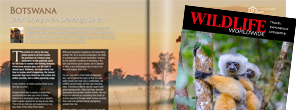Wildlife of the Pantanal & Amazon

Brazil's Pantanal is the world's largest tropical wetland. During a visit there earlier this year, my wildlife highlights included anchoring alongside a jaguar and watching statuesque storks strutting through water hyacinths.
After landing in Cuiaba we were met by our guide and began our journey to the Transpantineria, a name exciting and exotic in its own right and the start of our wildlife extravaganza in Brazil. Before we passed through the gateway, I was already dazzled by the numbers and variety of bird species, which included rhea, savannah hawk, roseate spoonbill and vermillion flycatcher. These were just some of the 30+ species that we saw on our transfer alone! We were welcomed to the Pantanal with a lucky sighting of three giant anteaters in the fields along the road, two of which were a mother with a tiny baby catching a ride on her back! An expert camouflage technique – hidden in plain sight.

Arriving into our lodge at dusk to a capybara-filled lawn and a refreshing glass of fresh watermelon juice, we were shown to our rooms before being whisked away to the ocelot hide. We were in luck and watched the elusive cat pose perfectly!

Whilst at the lodges along the Transpantieira, I had the opportunity to go on a nature walk in search of the mysterious and bizarre potoo and comical capuchin monkey, and also take a boat ride along the Pixaim River with beautiful birdlife. Here one can access the purpose built jabiru stork tower to view the nest or simply relax in the hammocks or by the pool, watching hummingbirds, bare-faced curassow and toco toucan.

The next morning we covered the remaining journey along the Transpantineira to Porto Jofre, our access point to the river systems and where we spent the next four nights. En route we saw great horned owl, purple gallinule and - at the port itself - the vivid blue hyacinth macaw.

Eager to get on the water, we began our journey upstream to the Three Brother’s River system. Herons, kingfishers and cormorants were prolific, perpetually traversing the waterways in front of the boat. As we navigated the vast mosaic of waterways, we kept our gaze locked to the gallery forest, adjusting our eyes to this new landscape in the hope of spotting the undisputed star of the Pantanal, the magnificent jaguar.

Over the next days we spent mornings and afternoons on boat excursions, exploring the area and its wildlife, returning to the lodge for lunch and to relax during the heat of the day. We watched giant river otter families play, shout and ‘dance’ on the river banks (scent marking) and capybara and caiman bathe on the exposed sandbanks, keeping a watchful eye out for jaguar.

The name jaguar is derived from the Native American word yaguar, meaning ‘he who kills with one leap’. Jaguars often keep to the river banks, keeping an eye out for potential prey of caiman and capybara, so being able to float parallel to them as they pick their way along the bank, or anchor and switch off the engine to stay with a resting jaguar, offers a unique way to view big cats. I was blown away by the beauty of these majestic cats and every one of the eight sightings (seven individuals) was unique and special.

The idyllic location of our lodge, set on the banks of the river and distanced upstream from the flotels along the busier stretches of the Cuiaba River, offered us a feeling of exclusivity and escape. It also gave us an incredible private jaguar encounter! On our day of departure, we rounded the first bend from our lodge to find a beautiful young male jaguar resting on a fallen tree above the water. We shared the stretch of river with this relaxed and beautiful cat, turning off the engine and floating alongside, knowing that we were likely to be the only people to see him on this day.

Reluctantly leaving the Jaguar Retreat, we headed back up the Transpantiera, seeing anaconda, red and green macaw and brocket deer on the way to our lodge. My neighbours here were a pair of hyacinth macaws and the highlight of my stay was an amazing encounter on foot with giant anteater. The area is much drier along the Transpantineria and pools are busy with caiman and water birds, offering excellent photo opportunities. Getting close to the caiman, you can see how their large teeth pierce through their upper jaw. Our night drive delivered us sightings of Brazilian tapirs, South America's largest terrestrial mammal, crab-eating fox and the eerie sight of a pool full of caiman eyes reflecting the beam of torch light!

Transferring from the Pantanal to Cuiaba, I boarded my plane to Alta Floresta, an agricultural town which serves as a gateway to the Brazilian Amazon, on my quest for harpy eagle. The Amazon has always held a mythical status and the harpy eagle is named after the half woman/half eagle monster of Greek mythology. My five days in the Amazon delivered the sense of wonder and adventure that I hoped for. Driving west from Alta Floresta to the Juruena River, past cattle and soya farms, we kept our eyes peeled to the sky to see the five species of macaw passing noisily over head.

Off the beaten tourist track, we made our way into the forest where we spent the next couple of days surrounded by nature. At sunrise we climbed the 90 step tower to the platform that looks onto the Brazil nut tree and the harpy eagle nest. Thirty metres away, in clear sight, was the ten-week old chick. As we watched the sunrise over the forest canopy, the dawn chorus of Amazon birds filled the air and paradise tanagers and macaws kept us company as we waited for the adult eagles to return.
Day one in the tower brought no luck and we busied ourselves scanning the trees for titi monkey and other Amazonian birds. It was a mixture of joy, relief and awe when, on the second day, the adult male harpy eagle graced the nest, delivering a meal to his equally overjoyed chick! Staring directly at us, the eagle emanated power and beauty in equal measure.

Whilst in the Amazon, we went on a series of nature walks through the forest, sighting endangered white-nosed bearded saki monkey, woolly monkey, squirrel monkey and capuchin. The quizzical face of a fully grown juvenile harpy eagle peered down to us on the canopy floor, and on boat trips along the pristine Juruena River we saw tropical bird species including hoatzin, red necked aracari, red throated piping guan and yellow-rumped cacique.
This was my first time to the Amazon and Pantanal and it was a whirlwind of new experiences and species. The variety and abundance here is astounding and I’m already eager to return!
Join us on a small group tour to see the abundant Wildlife of the Pantanal or contact Sarah to plan your very own tailor made trip to Brazil.








